FREE AP English Language and Composition Metaphor and Simile Practice Test Question and Answer
The passage's vocabulary and subject matter lead one to believe that the speaker is most likely
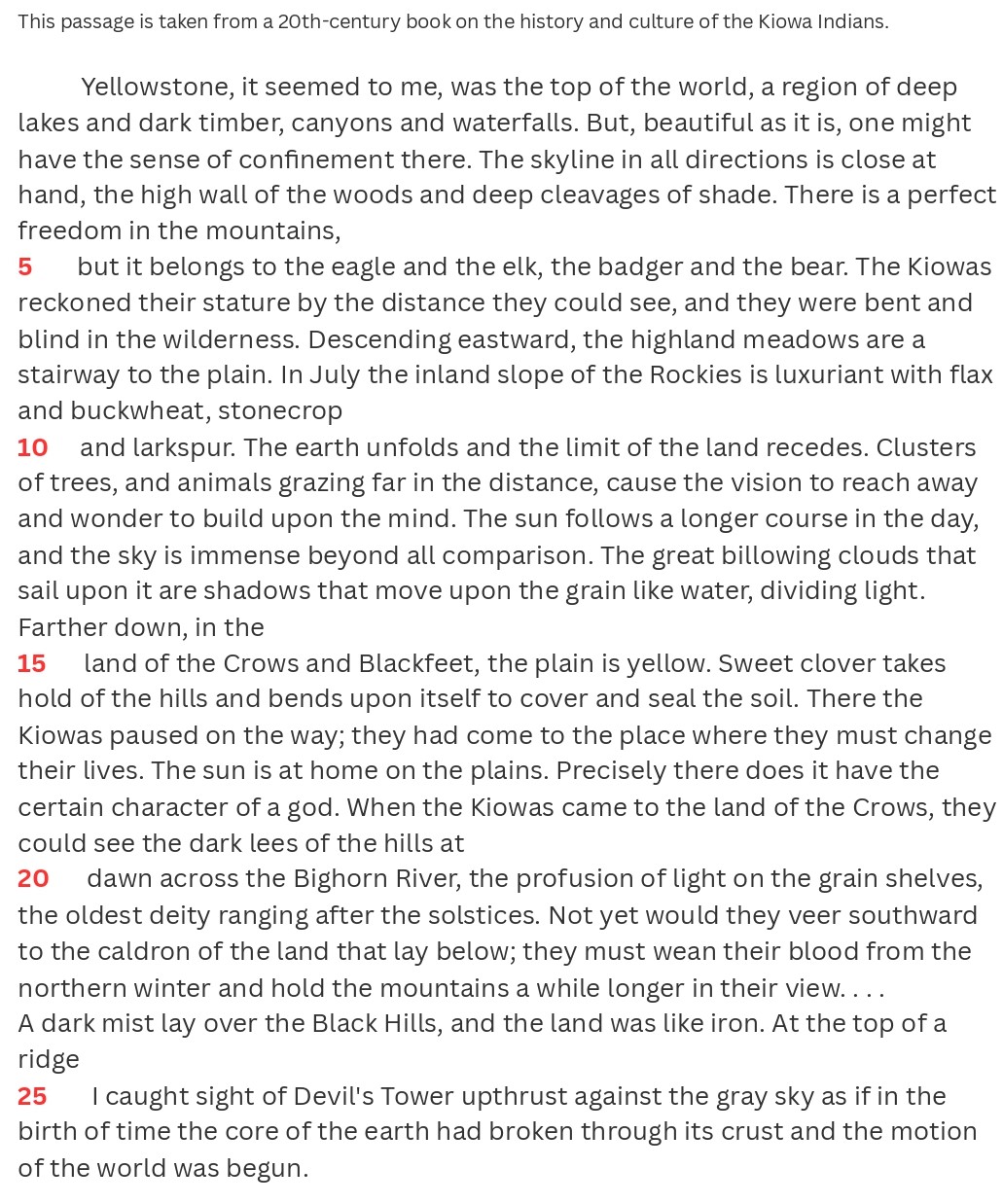
The speaker's great respect for the environment suggests that he has a close relationship with Yellowstone. It is practically sacred to him. (D) suggests that the speaker is a casual tourist, which is most definitely not the case given how he feels about the location. (E) fails to take into account the speaker's sparse mention of plant life in his account of the surroundings. Because the passage lacks evidence to back up (C), it is wrong. (A) cannot be the right answer. The speaker may be visiting Yellowstone for the first time based on his expression of awe at the surroundings.
Lines 5-7 of paragraph 1's final sentence's last clause's primary rhetorical purpose is
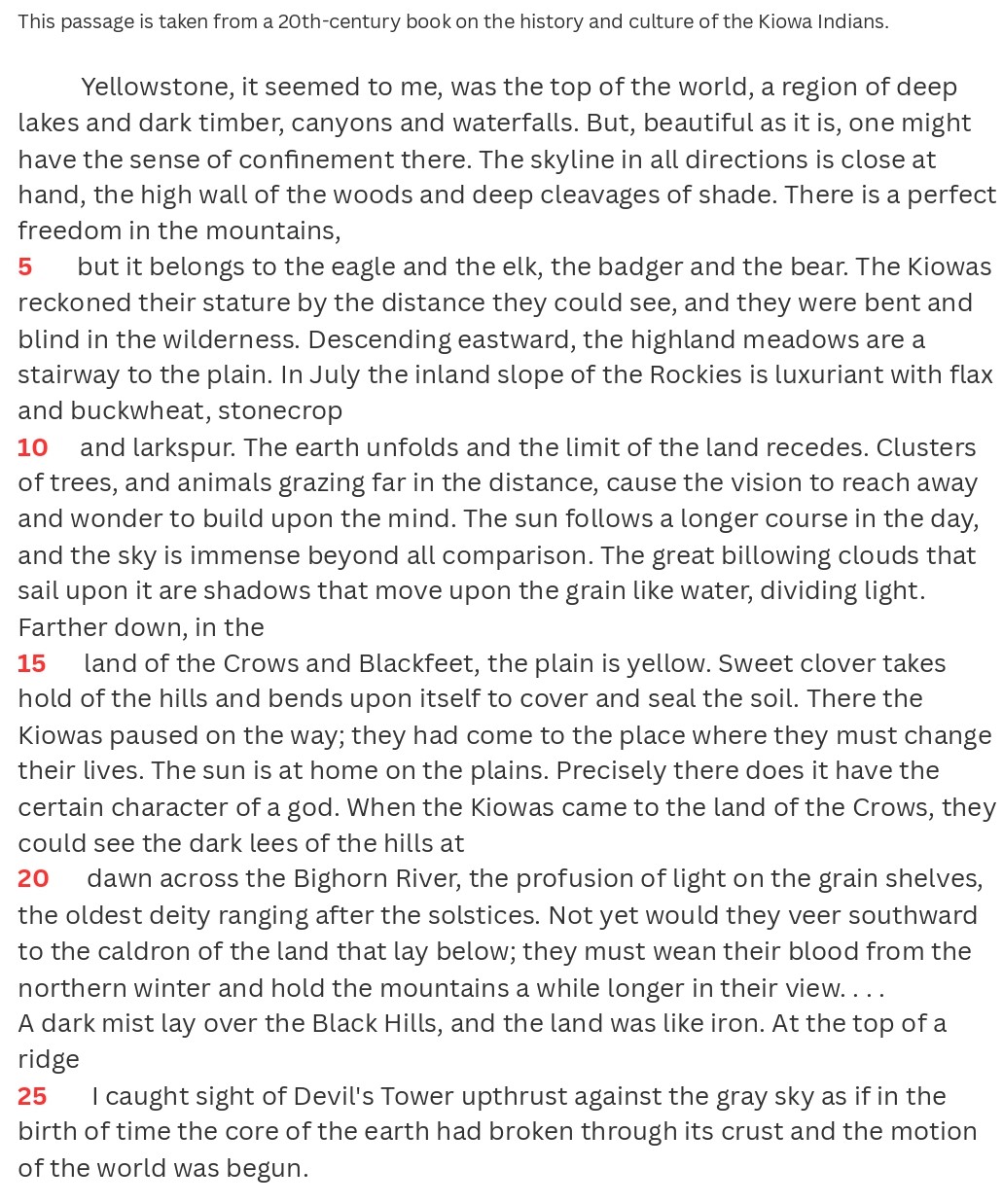
The sentence illustrates the impact of the above discussed "feeling of imprisonment." Since the discussion of the Kiowas is not immediately continued in paragraph 2, solution (B) is incorrect. Because the text just provides further information on the Kiowas, (E) is incorrect. Because the sentence doesn't directly contradict anything else in the text, (A) is incorrect. Since the idea of the Kiowas' freedom or imprisonment is abandoned after the first paragraph, the response (C) is inadmissible.
"Descending" alters line 8

The verb "descending" has adjective-like properties. The sentence's subject, the noun "meadows," is described (i.e., modified) by this clause.
Which of the following best sums up the second paragraph's initial sentence's rhetorical purpose?
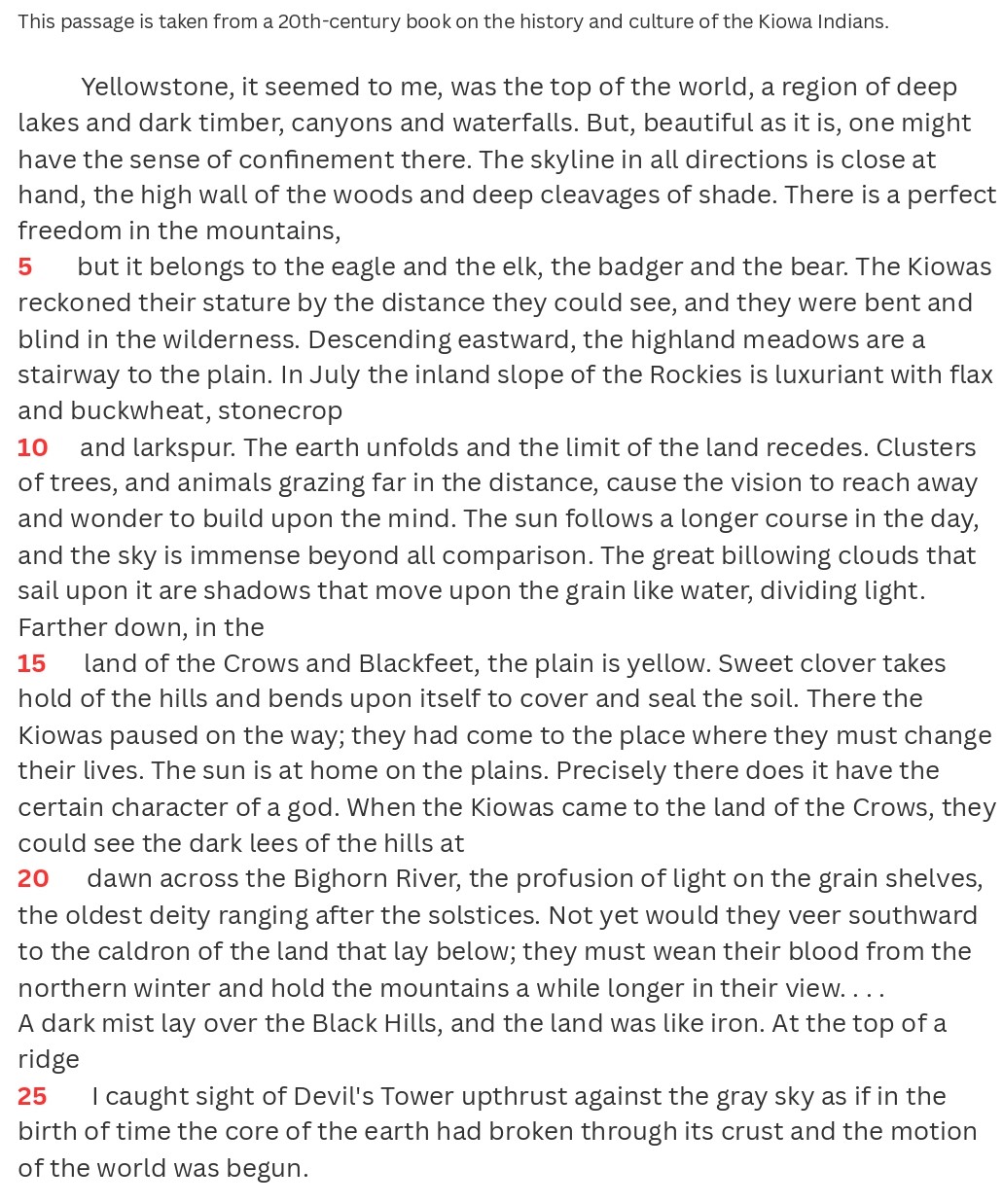
The phrase describes the "stairway to the plain," which leads the reader from the high country. The options (D) and (B) are irrelevant. (E) is wrong since the first paragraph is necessary for the author to fully explain the Kiowas' movement from the highlands to the plains in the south. Because the speaker has extensively examined the terrain, (A) is only partially incorrect. But displaying his expertise is not his main goal.
Which of the following rhetorical devices appears in lines 12–14?
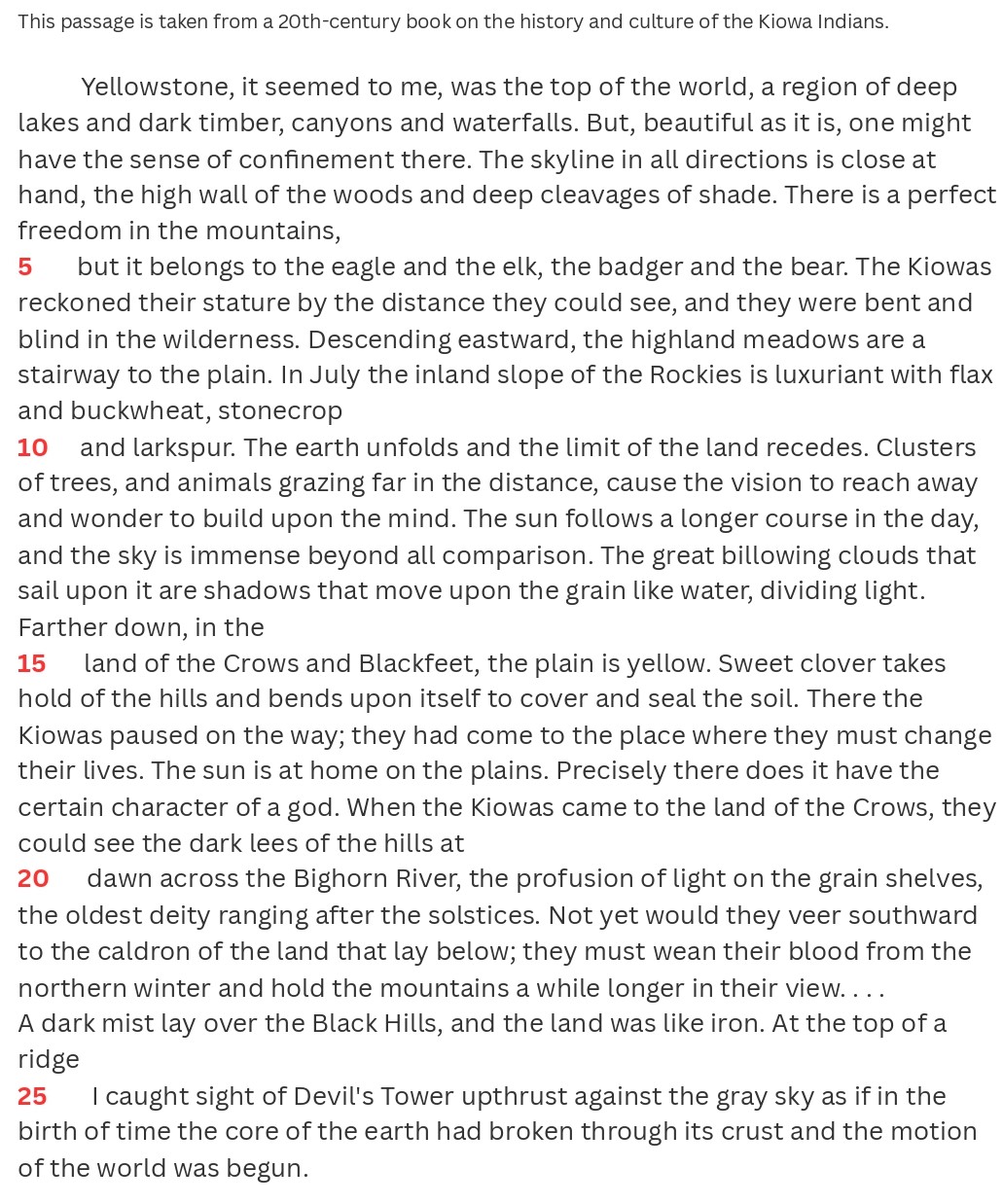
The phrases include similes like "move along the grain like water" and metaphors like "clouds... are shadows." You need to be familiar with the definitions of a number of rhetorical words, all of which are listed in the Glossary, in order to weed out the incorrect options.
The main comparison used by the passage's author is between
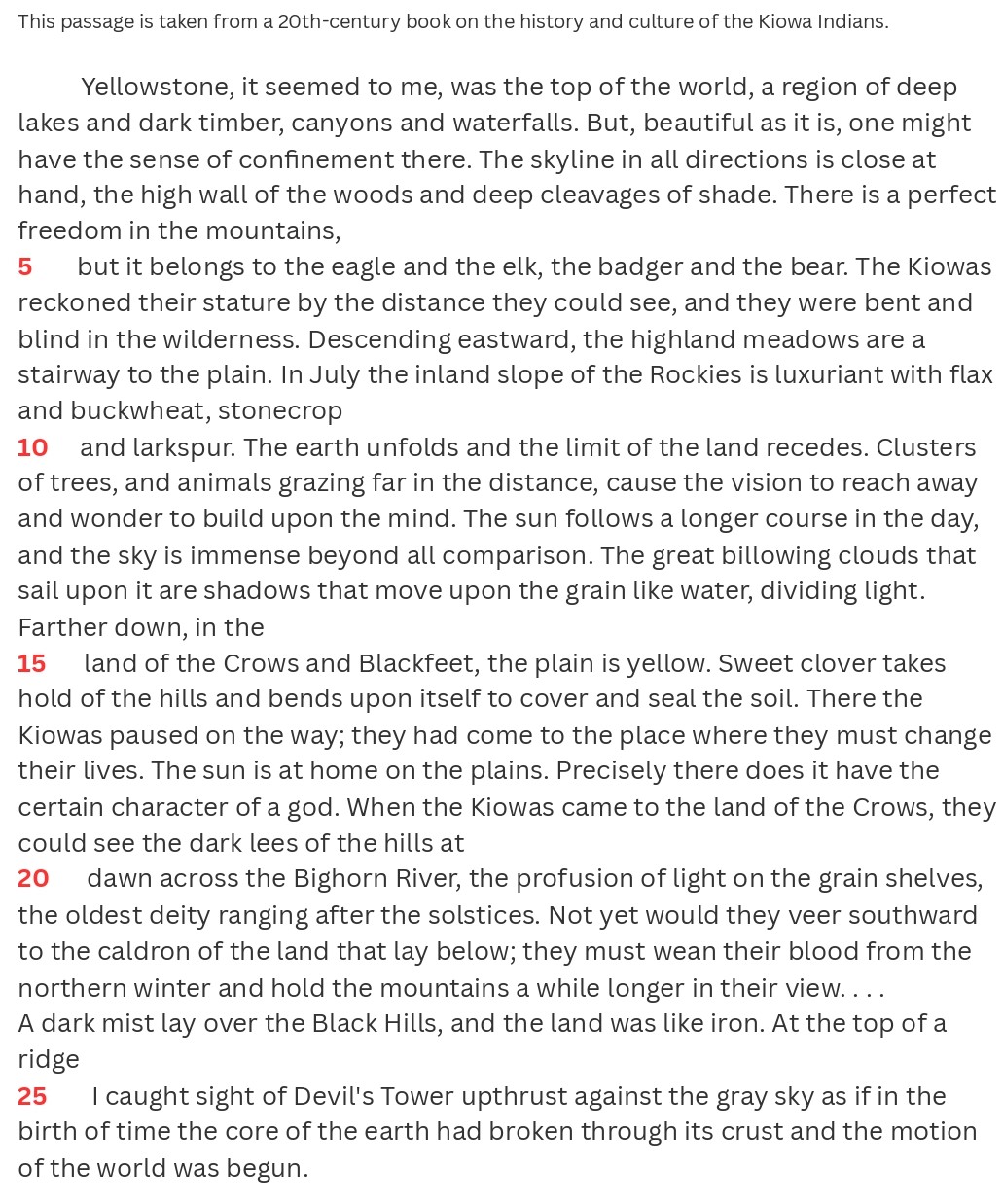
Lines 2 and 4 of the passage refer to the hilly Yellowstone region as having "black timber," while lines 15 and 16 refer to the sun-drenched plains as being "yellow" and having a "profusion of brightness" (line 20).
The best way to sum up the speaker's tone throughout the text is
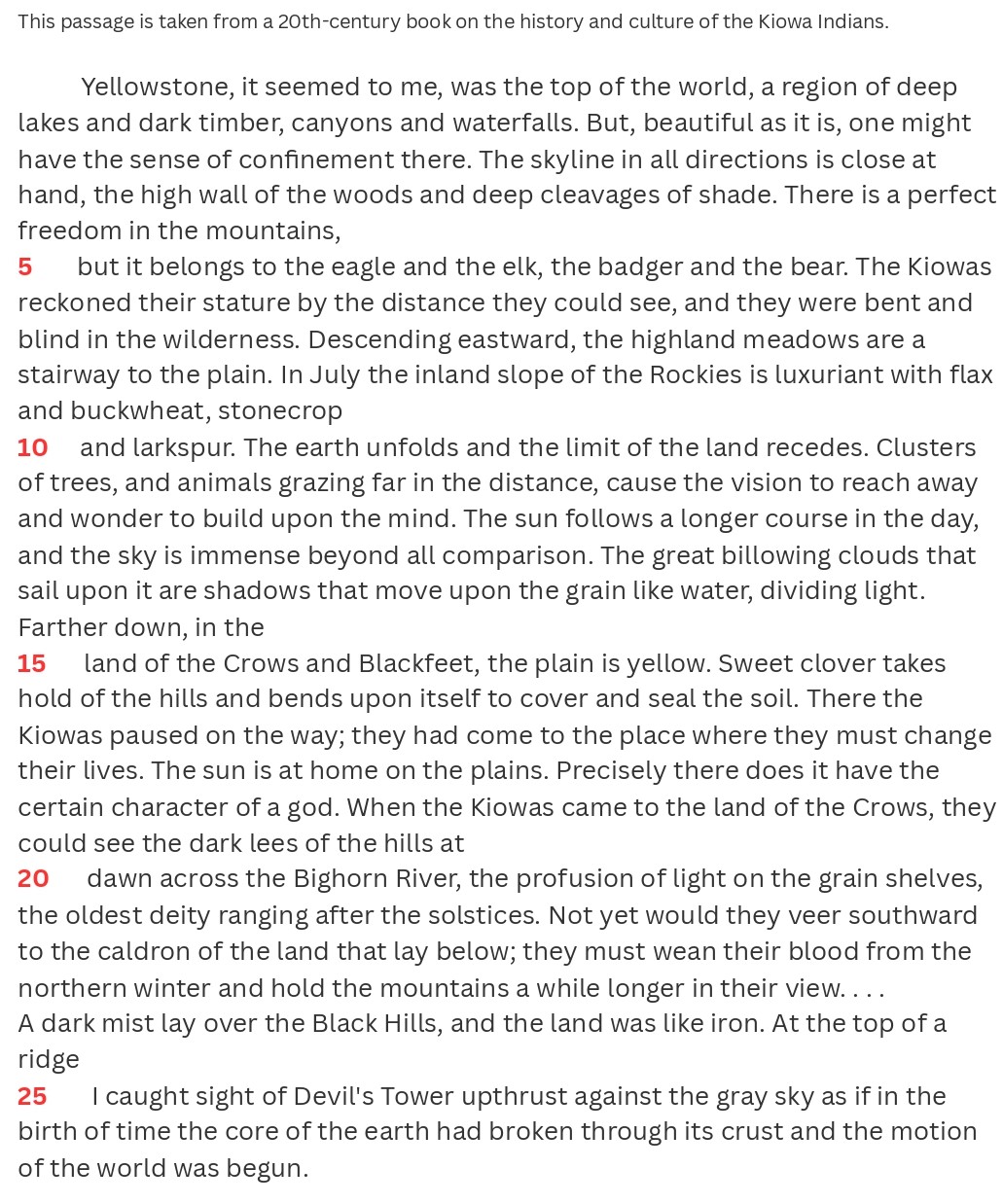
The poetic imagery in the text conveys the speaker's amazement and pleasure at the changing beauty of the landscape that the Kiowas once traversed. Part of (D) may be true; the speaker is sincere but not particularly profound. The passage is more impressionistic than intellectual, thus (C) is incorrect. Exotic does not adequately convey the location or the speaker's attitude in (A). The passage is not philosophical, hence the answer (B) is not a good option. Instead, a lot of it is grounded in reality.
Advertisement
All of the following are found in lines 17 through 21, EXCEPT
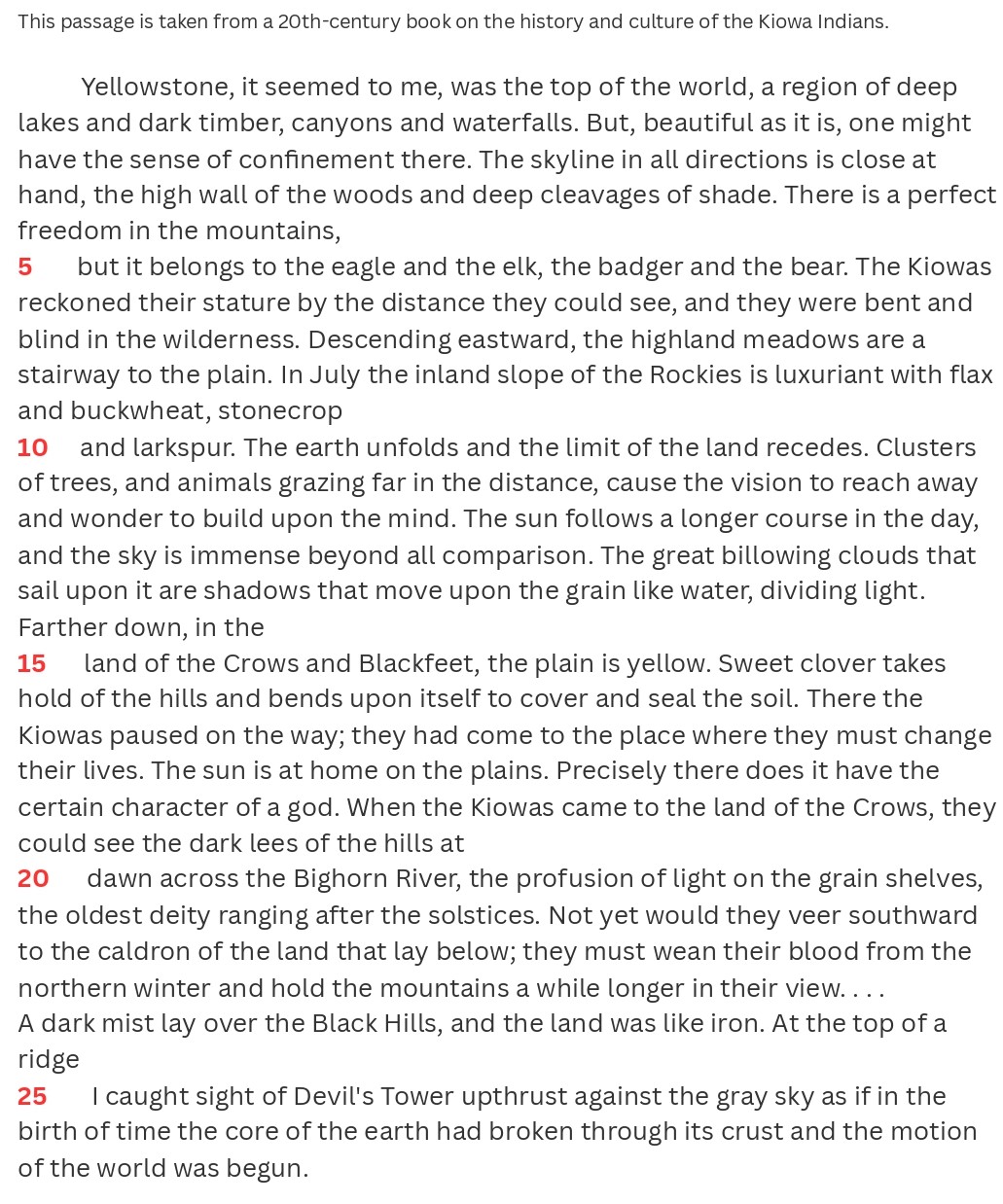
The broader comparison between the sun and a god, which includes the words "the oldest deity," is where options (D) and (E) can be found. The string of words starting with "dark lees" is an example of (B). The phrase that starts with "When the Kiowas..." contains (A).
The term "wean their blood" (line 22) is referred to as other things in the context.
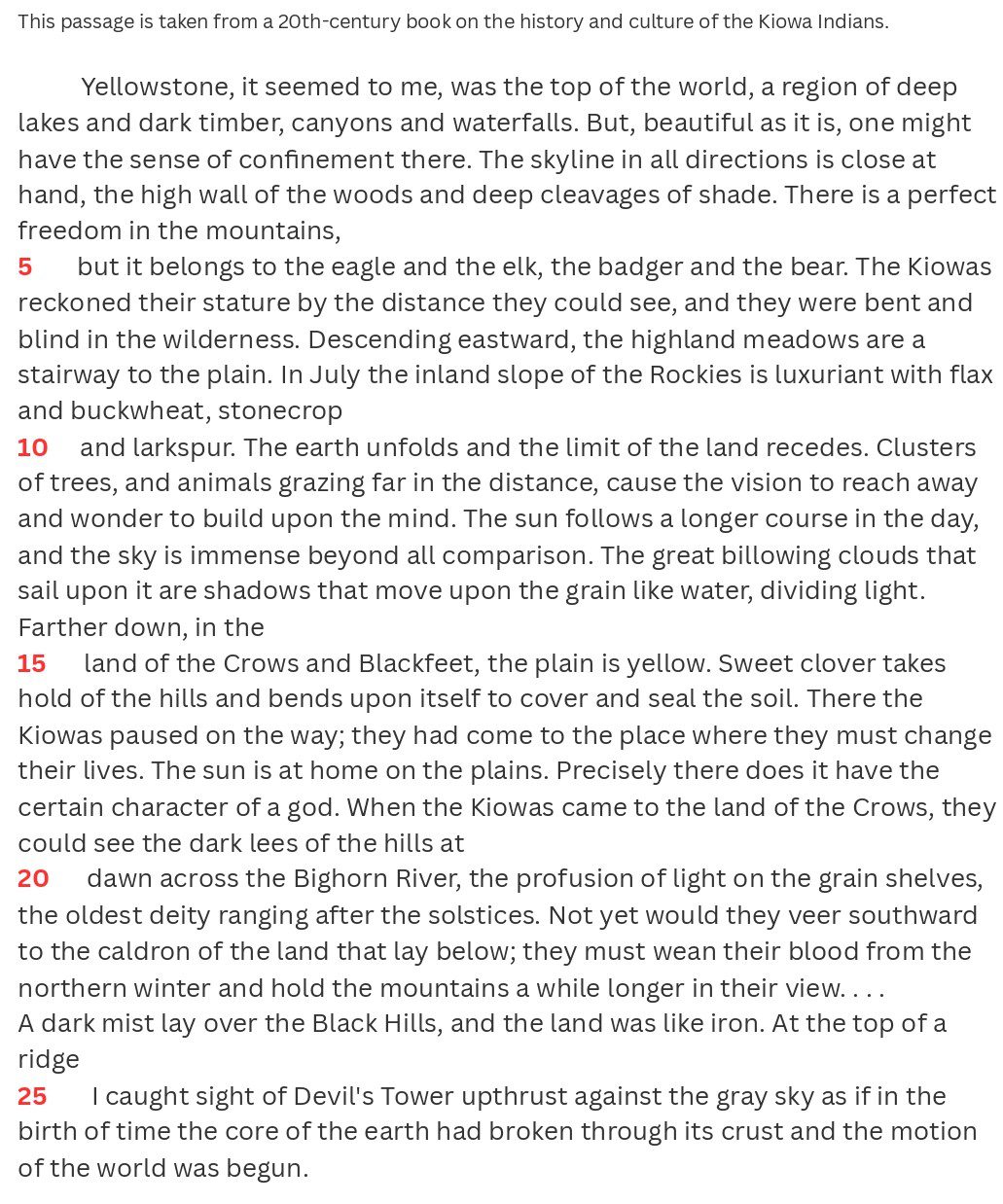
The expression alludes to the Kiowas' requirement to adjust to their new environment. Choice (A) is almost the right response, but it omits to explain why the Kiowas took a break from traveling south.
The easiest way to sum up the passage's rhetorical approach is
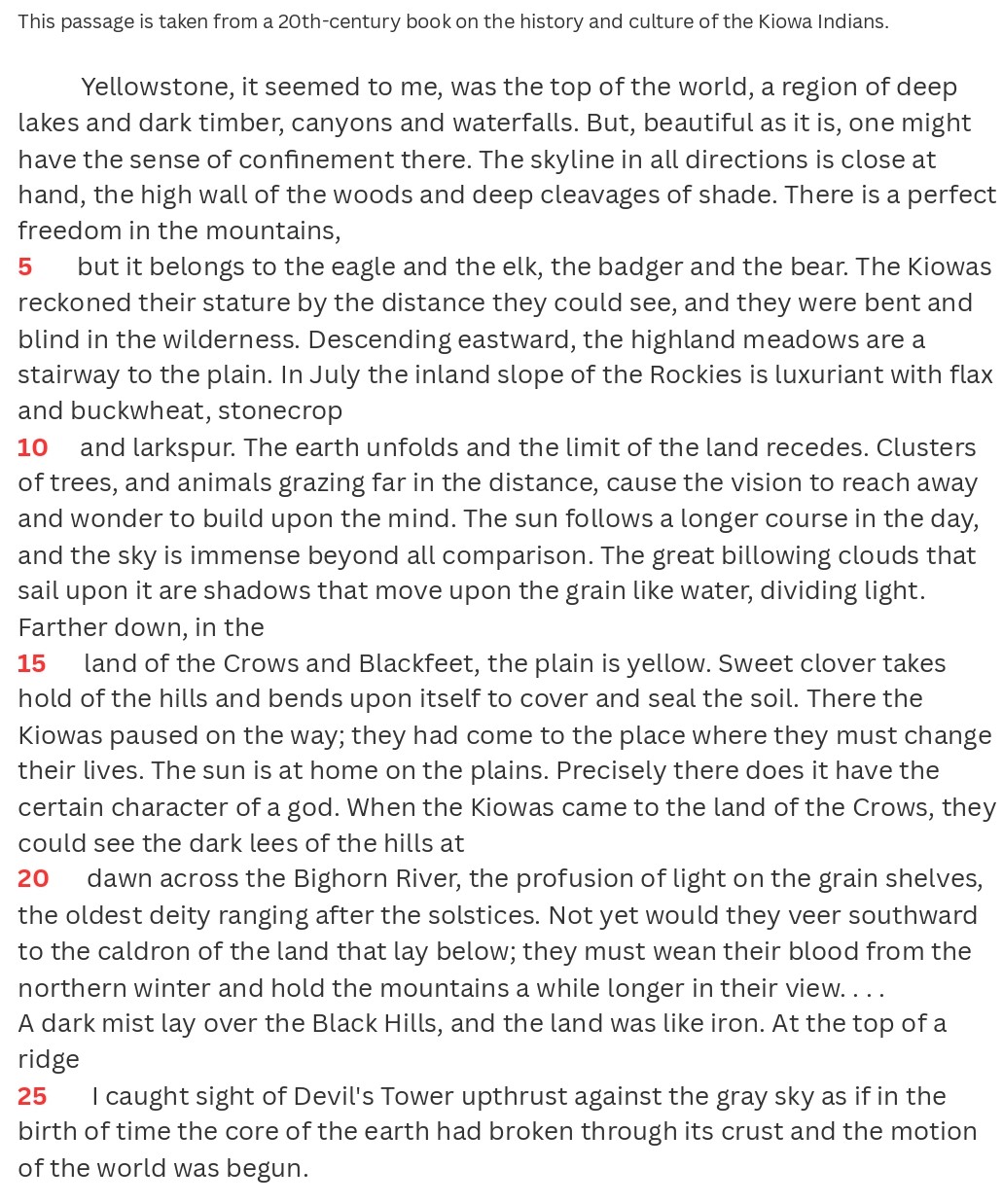
Fluent, rhythmic, and poetic language. The speaker uses rich imagery to describe the landscape. The passage's style is not adequately described by any of the four other adjectives.
Which of the following statements best describes how the final section (lines 24–27) adds to the passage's overall sense of coherence? I. It echoes the sense of darkness that dominated the first paragraph. II. It describes the land in ways that recall earlier descriptions. III. It brings the speaker's perspective back into the narrative.
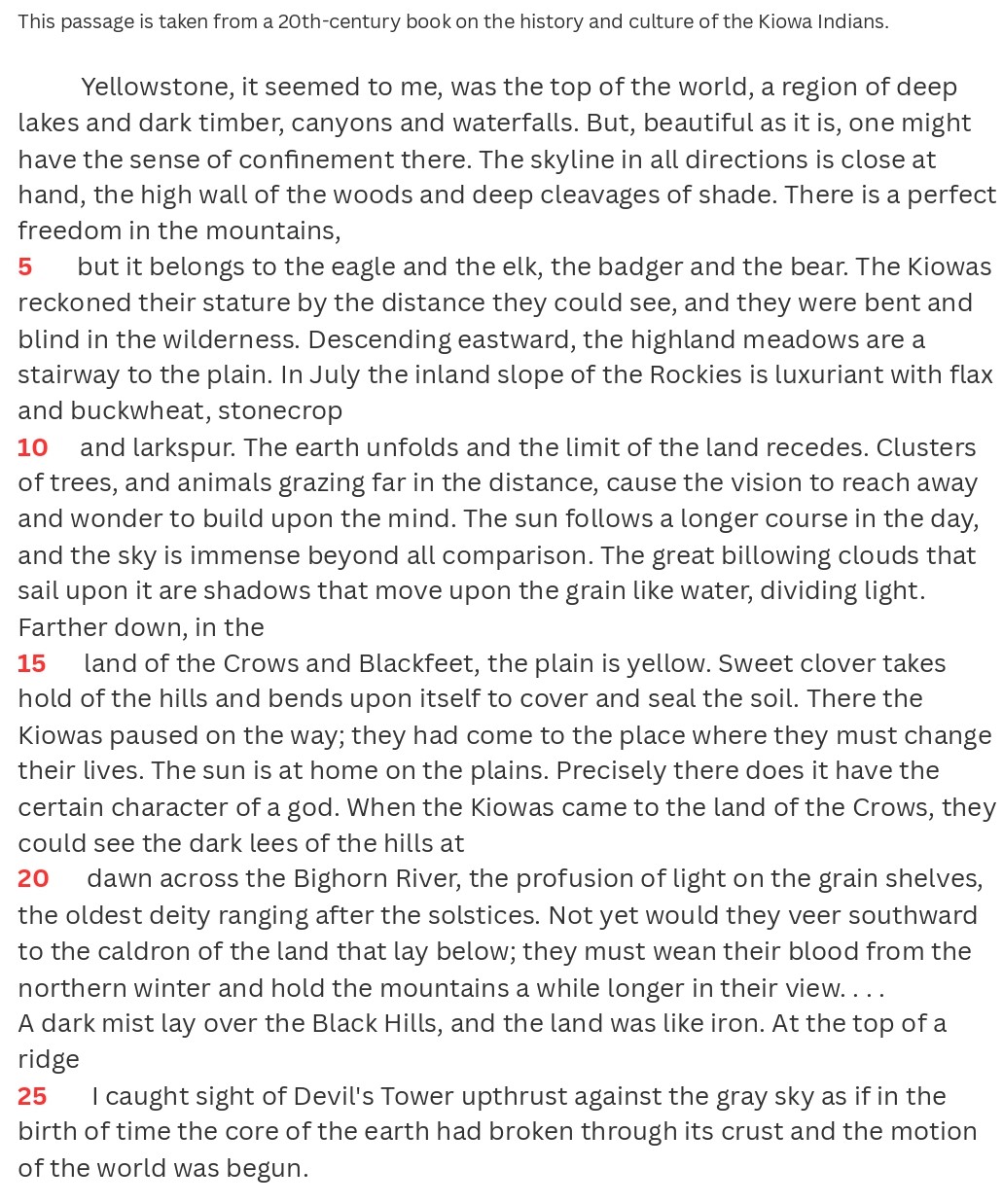
Darkness is a recurring theme in both the first and closing paragraphs. The speaker inserts himself into the story in both paragraphs as well: "it seemed to me" in the first and "I caught sight" in the last. The way the two paragraphs describe things is different. The first describes what the speaker sees and his reaction to it. In the other, the speaker's assessment of the surroundings is downright shocking.
In the opening paragraph, the passage's topic is introduced with
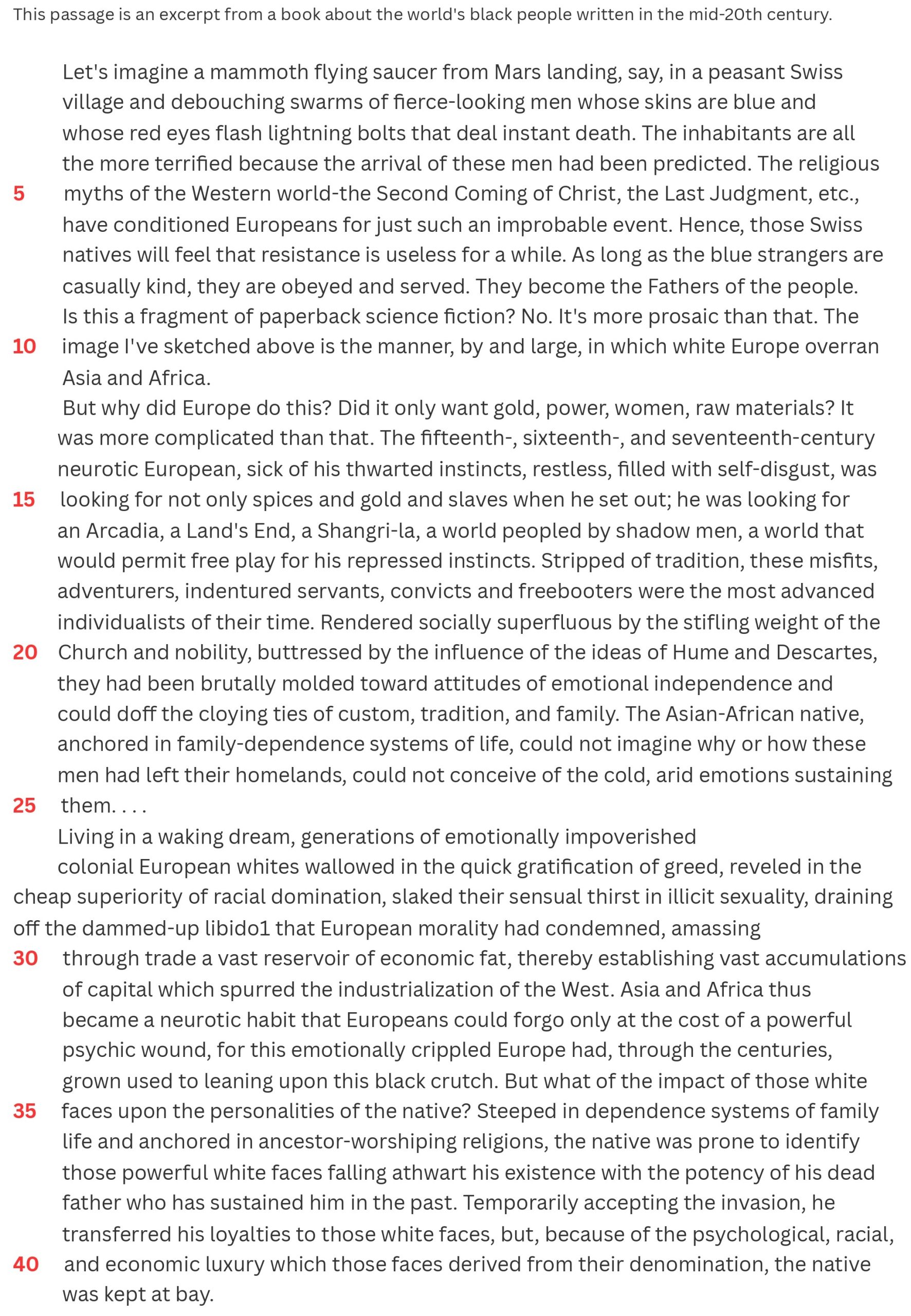
The fictional story of Martians capturing a Swiss village is a parable—a brief, made-up tale that serves to convey a moral or religious ideal. The narrative here depicts European appropriations of Asian and African communities. None of the other options apply: (D) is a factual disclosure of a questionable matter. (A) is a reference to a well-known individual, location, or object. (E) provides background information or context for a play or tale. A long, historical, episodic story following the adventures of a hero, their family, or a group of heroic individuals makes up the literary style known as (C).
Which of the following sums up the tone of the section the best?

The speaker harshly denounces Europeans who mistreated others in order to benefit financially. None of the other options are viable.
The speaker contrasts the Asian-African inhabitants and European colonists throughout the chapter based on
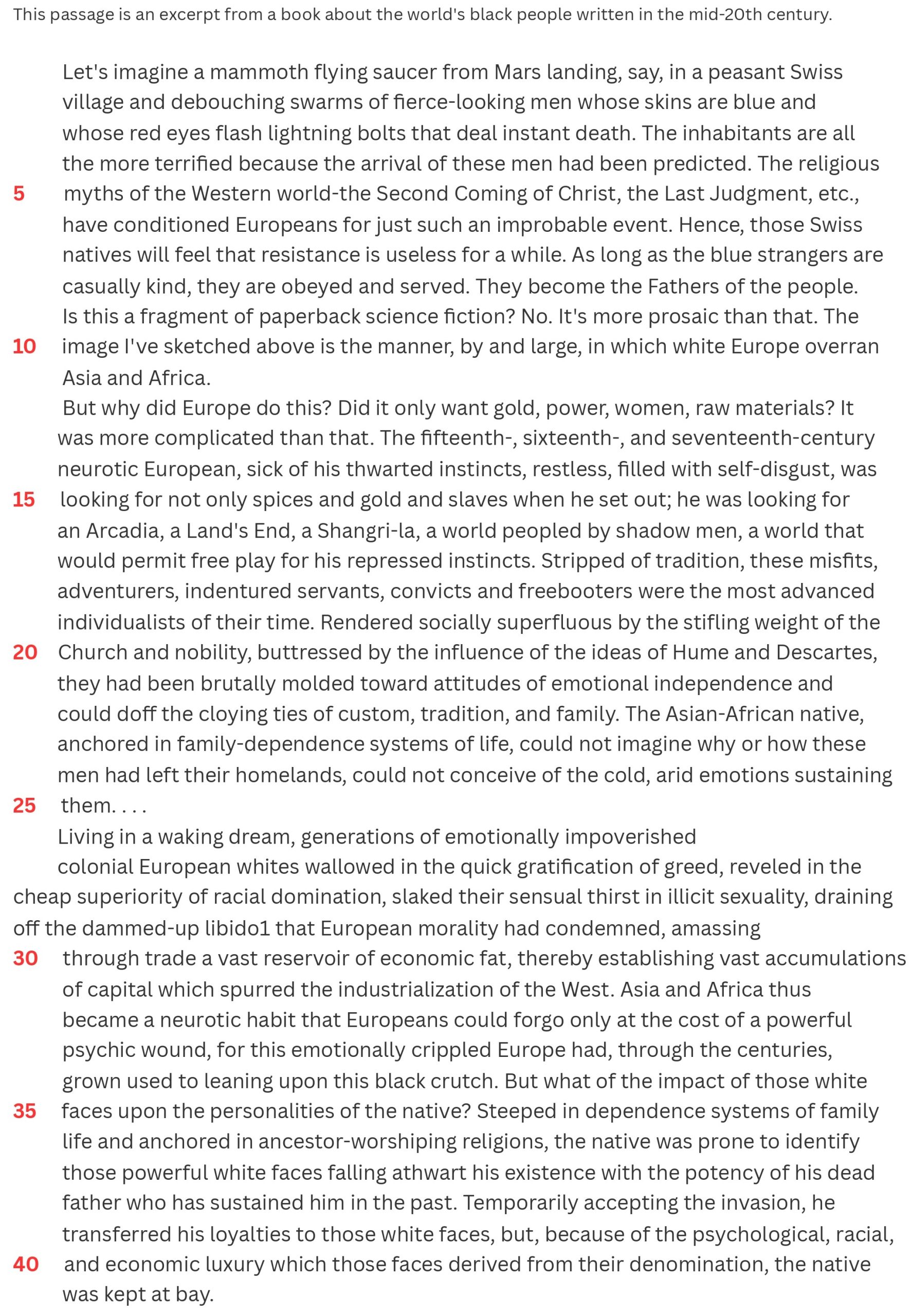
In the opening paragraph, the passage's topic is introduced with A. an allusion B. a parable C. a saga D. an exposé E. an exposition The fictional story of Martians capturing a Swiss village is a parable—a brief, made-up tale that serves to convey a moral or religious ideal. The narrative here depicts European appropriations of Asian and African communities. None of the other options apply: (D) is a factual disclosure of a questionable matter. (A) is a reference to a well-known individual, location, or object. (E) provides background information or context for a play or tale. A long, historical, episodic story following the adventures of a hero, their family, or a group of heroic individuals makes up the literary style known as (C). Which of the following sums up the tone of the section the best? A. Moralistic and circumspect B. Restrained and thoughtful C. Objective and impartial D. Irate and contentious E. Pedantic and nitpicking The speaker harshly denounces Europeans who mistreated others in order to benefit financially. None of the other options are viable. The speaker contrasts the Asian-African inhabitants and European colonists throughout the chapter based on A. the strength of their belief in God. B. their economic wealth. C. their attachment to the land. D. their attitude toward family life. E. their desire to own property. The two groups' fidelity to family life is the disparity that stands out the most. The colonists, according to the speaker, had severed their "links to family" (line 22). In contrast, the Indians were "[s]teeped in dependency patterns of family life" (lines 35–36). The other options have no significant part in the passage. Which of the following definitions of "Fathers" (line 8) is most supported by the context? A. Ruthless tyrants B. Priests C. Representatives D. Masters E. Role-models (E), (B), and (C) are improper in the context of the passage since line 8 states that the invaders are "obeyed and served," which implies that "Fathers" is another word for "Masters." Although the passage claims that strangers, unlike tyrants, are "casually nice" (line 8), at least initially, it is possible that the answer is (A). Which of the following rhetorical devices is most prevalent throughout the passage? A. The testimony of experts on the subject of European colonialism B. Specific examples and anecdotes to illustrate the main idea C. The use of highly-charged, emotional language to create an effect D. Well-reasoned logical argumentation in support of a thesis E. The testing of a hypothesis using observation and the massing of data Strong, almost inflammatory language predominates throughout the passage, beginning with the opening scenario of "fierce-looking men whose skins are blue and whose red eyes flash lightning bolts" (lines 2-3) and ending with the idea of a "emotionally crippled Europe... leaning upon this black crutch" (lines 33–34). The other options all describe a calmer, more traditional passage.
Advertisement
Which of the following definitions of "Fathers" (line 8) is most supported by the context?
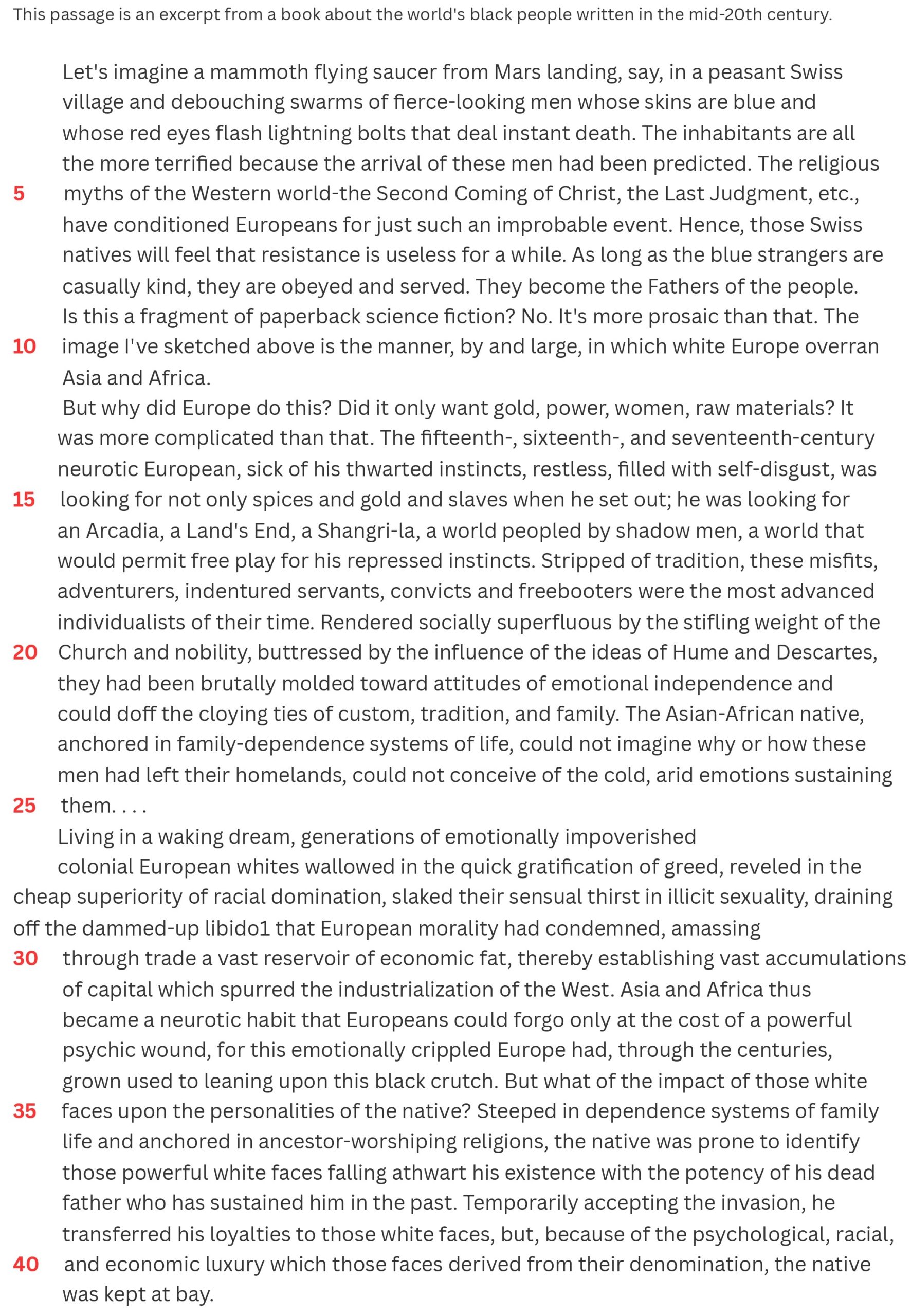
Which of the following rhetorical devices is most prevalent throughout the passage?

Strong, almost inflammatory language predominates throughout the passage, beginning with the opening scenario of "fierce-looking men whose skins are blue and whose red eyes flash lightning bolts" (lines 2-3) and ending with the idea of a "emotionally crippled Europe... leaning upon this black crutch" (lines 33–34). The other options all describe a calmer, more traditional passage.